A guide to planting carrots for the winter for beginner gardeners
Planting carrots before winter is a great way to get a harvest in June, while spring sowing roots are just entering the stage of milk ripeness. Winter carrots grow larger, juicy and sweeter due to sufficient soil moisture with melt water.
In this article, we will tell you which carrots to plant in the fall, how to prepare the site and take care of the crop in the spring.
The content of the article
Advantages and disadvantages of the method
Benefits of sowing carrots in winter:
- early harvest;
- the opportunity to devote more time to preparing the site for the spring season;
- podzimny root crops grow larger, contain more sugar and water due to the supply of melt water;
- when harvesting in June, space is freed up for sowing fast-growing crops - greens, lettuce, beets, cabbage, legumes.
The disadvantage of this method is the short shelf life of root crops.
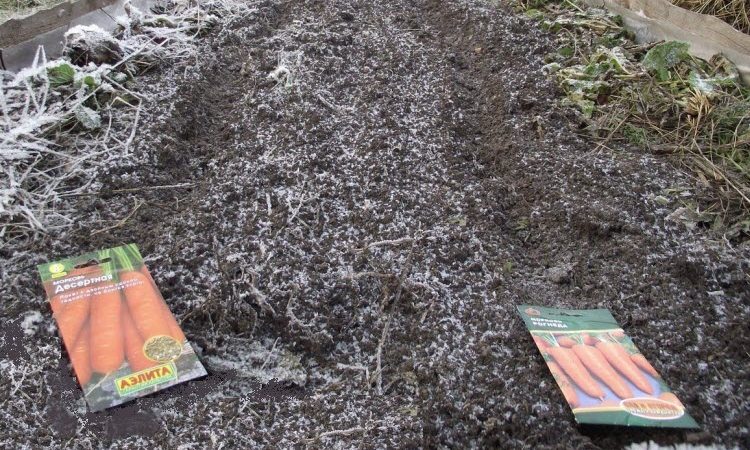
Suitable varieties of carrots
Early and mid-season varieties are best suited for sowing before winter. The bunch carrots have proven themselves very well. Early ripening and cold-resistant varieties with a high percentage of seed germination give a rich harvest.
The table shows the most popular and proven carrot varieties.
| Name | Ripening period (days) | Weight, g | Length, cm | Coloration | The form | Productivity, c / ha |
| Vitamin 6 | 100-110 | 70-90 | 17-20 | Orange | Cylindrical | 199-491 |
| NIIOH 336 | 98-113 | 100-122 | 18-20 | Red-orange | Cylindrical | 49-83 |
| Moscow winter | 70-100 | 100-170 | 15-18 | Orange | Conical | 500-700 |
| Shantane-2461 | 90-130 | 150-200 | 10-15 | Orange | Conical | 100-200 |
| Incomparable | 90-115 | 90-220 | 17-22 | Orange | Conical | 350-600 |
| Losinoostrovskaya 13 | 85-115 | 70-155 | 15-18 | Orange | Cylindrical | 550-700 |
| Nantes 4 | 80-120 | 90-160 | 12-16 | Orange | Cylindrical | 262-305 |
| Altai shortened | 110-120 | 70-150 | 18-22 | Orange | Conical | 299-564 |
| Autumn queen | 120-130 | 85-230 | 18-23 | Orange | Conical | 300-470 |
| Nastena-sweet | 100-120 | 100-150 | 20-23 | Orange | Cylindrical | 315-433 |
| Dayana | 110-120 | 100-160 | 17-20 | Orange | Conical, pointed | 210-434 |
Sowing dates before winter
Podzimny sowing is carried out in October-November in the middle lane and in early December - in the southern regions. There is no exact sowing date. Experienced farmers advise to be guided by weather conditions - the soil should freeze slightly.
In the warm ground, podzimny sowing is not performed, otherwise the seeds will hatch ahead of time.
Lunar calendar
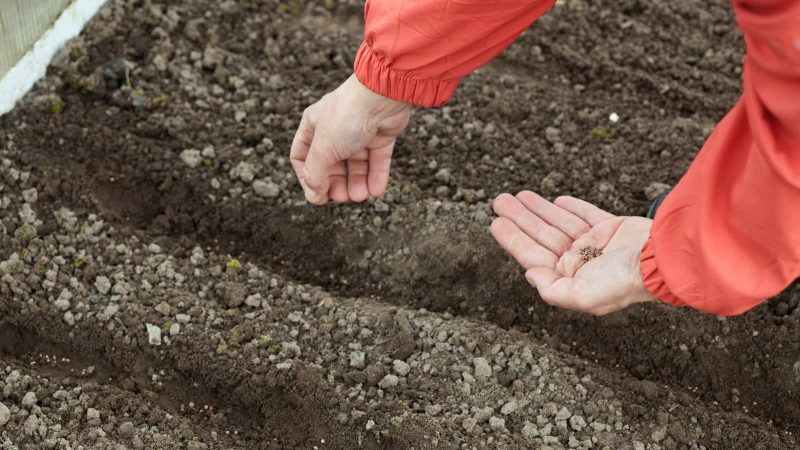
Favorable days of sowing carrots for 2019:
- October: 1-5, 8-9, 15-20, 25, 28-31;
- November: 2, 3, 4, 6, 7, 13, 14, 17, 18, 20, 21, 24, 26-28;
- December: 2, 3, 4, 9, 10.
Auspicious days of sowing carrots for 2020:
- October: 4, 6, 7, 8, 14, 15, 17, 20, 22;
- November: 1-7, 10, 12, 16, 17, 19, 21, 22, 28, 29;
- December: 1, 2, 6-10.
Preparatory work
When sowing carrots in winter, the main emphasis is on soil preparation. Seeds do not need pre-sowing treatment.
Seeds
For sowing carrots before winter, dry seed material is used without preliminary preparation. Soaked or pelleted seeds (in a nutritious shell) germinate in the fall and die during the first frost... Dry seeds overwinter in the soil until spring, and then germinate rapidly with the arrival of heat.
The amount of sowing material is increased by 20-25% compared to spring sowing - some of the seeds will inevitably freeze out in winter, some will not "wake up".
Priming
After the autumn harvest, plant residues are completely removed from the site and the soil is dug to a depth of 25-30 cm. Potash, phosphate and nitrogen fertilizers, organic matter (peat, compost, humus) are simultaneously applied. The composition and amount of fertilizers applied depends on the nutritional value of the soil.
With a phosphorus deficiency, carrots grow a curve, with an excess of nitrogen, root crops branch out strongly. The culture reacts to fresh manure with ugly, branched and tasteless root crops.
The most favorable period for top dressing is after harvesting or during autumn plowing.
The first a portion of fertilizers should contain 15 g of double superphosphate, 15 g of urea, 15 g of potassium nitrate per 10 liters of water. Consumption - for 1 sq. m.
Second a portion is introduced after 3-4 weeks: 20 g of potassium chloride and 20 g of "Nitrofoski" per 10 liters of water. Consumption - for 1 sq. m.
Important! After planting a fresh mullein in the soil, carrots are allowed to be sown only after 1.5-2 years.
Normalization of nutritional value, improvement of the structure and looseness of the soil are the primary tasks of the gardener. The soil should be loamy, nutritious, with a neutral pH = 6.5-7 units. To deoxidize acidic soil, ash, slaked lime or dolomite flour are used - 400-500 g per 1 sq. m.
In early October, the soil is loosened, leveled and long furrows 3-5 cm deep are formed, the bottom is compacted with a wooden bar. In this form, the beds are left until frost.
Separately, soil is harvested for backfilling furrows and mulch. The prepared soil mixture is poured into the bags and stored indoors at temperatures up to + 10 ° C ... + 12 ° C, so that the earth does not freeze and dries up a little.
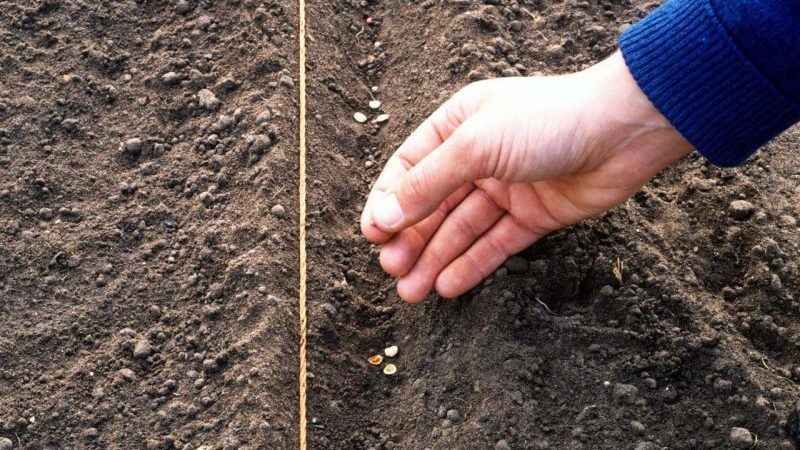
Crop rotation rules
When growing carrots, it is important to observe crop rotation. The culture grows best after potatoes, garlic, onions, tomatoes, cucumbers, zucchini, pumpkin.
Re-sowing in the same area is performed after 3-4 years. This will reduce the number of carrot flies in the area.
The soil for growing carrots should be loose and nutritious, ideally sandy loam. Clayy, heavy soil is not the best option: seeds in such conditions sprout for a long time and painfully.
The plot is chosen from the south side of the garden, with good lighting, early snow melting, and no drafts.
Autumn sowing technology for carrots
Sowing carrot seeds begins after the soil freezes to a depth of 3-5 cm. If snow falls, it is simply removed from the beds. A 1-2 cm layer of earth is poured into the furrows in order to seal the seeds to a depth of 1.5-2 cm on loose soil and 1 cm on dense soil.
The seeds are sown thickly, covered with prepared soil mixture and mulched with peat, humus, compost, pouring a layer up to 3 cm. The first snow is shoveled into the beds.
If the winter is snowy and frosty, the beds are covered with spruce or pine needles, large branches, dry foliage, and sawdust.
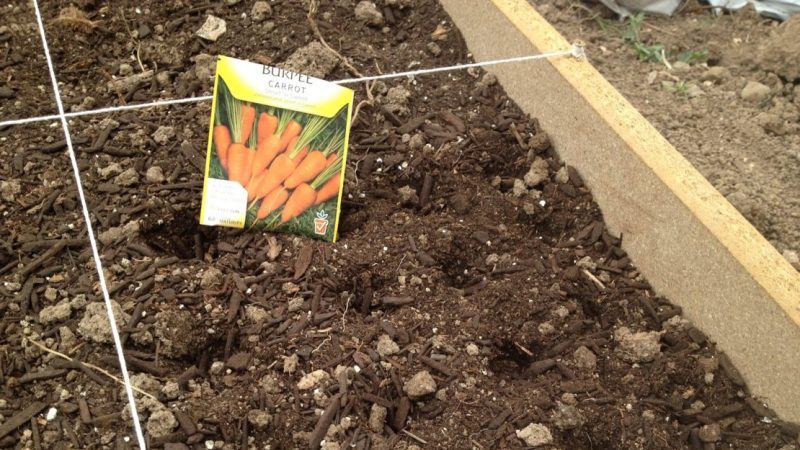
Further care
After sowing carrots before winter, the gardener needs to exhale and wait for the arrival of spring. From the moment the snow melts, the most interesting thing begins - planting care.
The first step is to remove mulch from the beds. To accelerate the emergence of seedlings, low arcs are placed over the beds and a film or non-woven material is fixed. After a stable average daily temperature of + 15 ° C and above is established, the shelter is removed.
The first watering is performed after the topsoil dries out.
With the first shoots, regular weeding begins. It is important not to allow the appearance of an earthen crust, which impairs the aeration of the underground part of the plant. Weeds are harvested as they grow.
At the beginning of the growing season, the soil is enriched with nitrogen, phosphorus and potassium. It is not recommended to add organic compounds.
Further care does not differ from the care of spring plantings:
- Thinning of crops after the appearance of 2-3 true leaves. Leave a gap of 3-4 cm between the shoots. The procedure is repeated two weeks later, leaving a distance of 4-5 cm. The soil is moistened, the greens are pulled out without loosening, so as not to damage the neighbors' main root, otherwise the root crop will grow "bearded". Holes in the ground are covered and compacted.
- The beds are sprinkled as the carrots grow, sprinkling the tops with earth. The areas that are outside turn green, they accumulate solanine, which gives the root crops a bitterness.
- Carrots require moderate watering.Root crops are formed at the end of the growing season and do not tolerate excess moisture well, becoming covered with cracks. In drought, the beds are watered three times a week, and in moderate weather - 1-2 times a week. Watering rate - 4 liters per 1 sq. m. As the root crops grow, the water consumption is increased to 8-10 liters per 1 sq. m.
The plant is fed from the moment 3-4 true leaves appear:
- I feeding: 25 g "Nitrofoski" per 10 liters of water;
- II feeding after two weeks: 1 liter of wood ash per 10 liters of water.
For the prevention of carrot flies, onions, marigolds, cilantro, garlic are sown next to carrots. Strong plant odor repels insects.
The most effective way to prevent the spread of the pest is to cover the beds with lutrasil or spunbond. The dense non-woven fabric prevents flies from entering the ground where they lay their eggs.
Harvesting after winter sowing is carried out in late June - early July. Carrots, sown in spring, are just ripening during this period.
Nuances for different regions
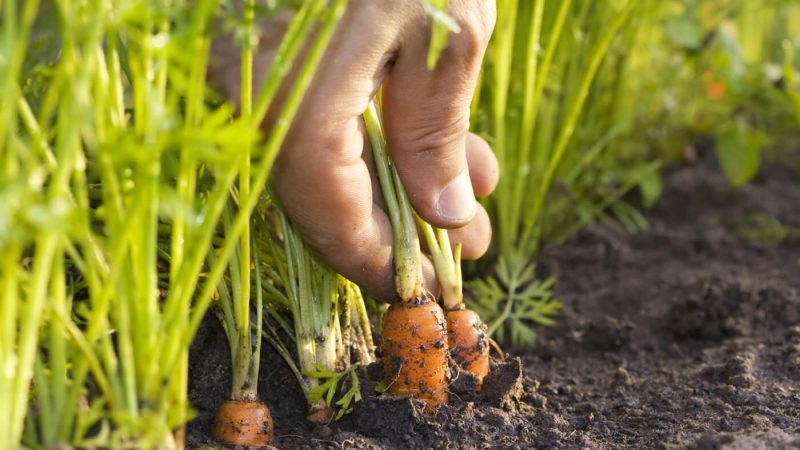
Sowing and care work with carrots is the same for all growing regions, only the sowing dates differ:
- In the middle lane (Moscow region), carrot seeds are buried in the ground in late October - early November, focusing on weather conditions. The dates may shift. The soil temperature should drop by 2-3 ° C. The seeding depth is 5-6 cm.
- In the North-West (Leningrad Region) - in the middle of November.
- In the Urals and the Volga region, carrots are sown in the same period as in the Moscow region. Planting depth and soil temperature are identical.
- In Siberia, the autumn planting of carrots is carried out from mid-October to mid-November. The beds are located on a hill so that with the arrival of spring the snow will melt faster. Sowing depth - 2-3 cm.
- In the south of Russia - at the end of November - in the first decade of December. Sowing depth - 2-3 cm.
Conclusion
Planting carrots before winter in October - December allows you to get an early harvest in June - July. For sowing, time-tested early and mid-early varieties with high productivity and excellent taste are chosen. Root vegetables grow sweeter and juicier. This is facilitated by the early feeding of the plant with melt water.
Care for podwinny carrots begins from the moment the first shoots appear. It is no different from caring for spring plantings and provides for regular loosening of the earthen crust, weeding, moderate watering, thinning seedlings and hilling the beds, applying fertilizing and preventing the spread of carrot flies.